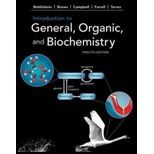
Introduction To General, Organic, And Biochemistry
12th Edition
ISBN: 9781337571357
Author: Frederick A. Bettelheim, William H. Brown, Mary K. Campbell, Shawn O. Farrell, Omar Torres
Publisher: Cengage Learning
expand_more
expand_more
format_list_bulleted
Concept explainers
Question
Chapter 17.5, Problem 17.2QC
Interpretation Introduction
(a)
Interpretation:
Write the equation for the reaction of butanoic acid with ammonia and name the salt formed.
Concept Introduction:
The reaction of carboxylic acids and bases results in the formation of water soluble salts.
Interpretation Introduction
(b)
Interpretation:
Write the equation for the reaction of (s)-Lactic acid with ammonia and name the salt formed.
Concept Introduction:
The reaction of carboxylic acids and bases results in the formation of water soluble salts.
Expert Solution & Answer
Want to see the full answer?
Check out a sample textbook solution
Students have asked these similar questions
>
You are trying to decide if there is a single reagent you can add that will make the following synthesis possible without any other
major side products:
1. ☑
CI
2. H3O+
O
Draw the missing reagent X you think will make this synthesis work in the drawing area below.
If there is no reagent that will make your desired product in good yield or without complications, just check the box under the
drawing area and leave it blank.
Click and drag to start drawing a
structure.
Explanation
Check
?
DO
18
Ar
B
© 2025 McGraw Hill LLC. All Rights Reserved. Terms of Use | Privacy Center | Accessibility
Don't use ai to answer I will report you answer
Consider a solution of 0.00304 moles of 4-nitrobenzoic acid (pKa = 3.442) dissolved in 25 mL water and titrated with 0.0991 M NaOH. Calculate the pH at the equivalence point
Chapter 17 Solutions
Introduction To General, Organic, And Biochemistry
Ch. 17.2 - Prob. 17.1QCCh. 17.5 - Prob. 17.2QCCh. 17.5 - Prob. 17.3QCCh. 17 - 18-4 Answer true or false. (a) The functional...Ch. 17 - Prob. 2PCh. 17 - 18-6 Name and draw structural formulas for the...Ch. 17 - 18-7 Write the IUPAC name for each carboxylic...Ch. 17 - 18-8 Write the IUPAC name for each carboxylic...Ch. 17 - Prob. 6PCh. 17 - Prob. 7P
Ch. 17 - Prob. 8PCh. 17 - Prob. 9PCh. 17 - Prob. 10PCh. 17 - 18-14 Answer true or false. (a) Carboxylic acids...Ch. 17 - 18-15 Draw a structural formula for the dimer...Ch. 17 - 18-16 Propanedioic (malonic) acid forms an...Ch. 17 - 18-17 Hexanoic (caproic) acid has a solubility in...Ch. 17 - 18-18 Propanoic acid and methyl acetate are...Ch. 17 - 18-19 The following compounds have approximately...Ch. 17 - Prob. 17PCh. 17 - Prob. 18PCh. 17 - Prob. 19PCh. 17 - 18-23 Characterize the structural features...Ch. 17 - Prob. 21PCh. 17 - Prob. 22PCh. 17 - 18-26 Answer true or false. (a) Carboxylic acids...Ch. 17 - Prob. 24PCh. 17 - 18-28 Arrange these compounds in order of...Ch. 17 - 18-29 Complete the equations for these acid—base...Ch. 17 - 18-30 Complete the equations for these acid-base...Ch. 17 - 18-31 Formic acid is one of the components...Ch. 17 - Prob. 29PCh. 17 - Prob. 30PCh. 17 - Prob. 31PCh. 17 - Prob. 32PCh. 17 - Prob. 33PCh. 17 - Prob. 34PCh. 17 - 18-38 Which is the stronger base: CH3CH2NH2 or...Ch. 17 - Prob. 36PCh. 17 - Prob. 37PCh. 17 - 18-41 Complete these examples of Fischer...Ch. 17 - Prob. 39PCh. 17 - Prob. 40PCh. 17 - Prob. 41PCh. 17 - Prob. 42PCh. 17 - 18-46 Procaine (its hydrochloride salt is marketed...Ch. 17 - 18-47 Methylparaben and propylparaben are used as...Ch. 17 - 18-48 4-Aminobenzoic acid is prepared from benzoic...Ch. 17 - Prob. 46PCh. 17 - Prob. 47PCh. 17 - Prob. 48PCh. 17 - Prob. 49PCh. 17 - Prob. 50PCh. 17 - Prob. 51PCh. 17 - Prob. 52P
Knowledge Booster
Learn more about
Need a deep-dive on the concept behind this application? Look no further. Learn more about this topic, chemistry and related others by exploring similar questions and additional content below.Similar questions
- What is the name of the following compound? SiMe3arrow_forwardK Draw the starting structure that would lead to the major product shown under the provided conditions. Drawing 1. NaNH2 2. PhCH2Br 4 57°F Sunny Q Searcharrow_forward7 Draw the starting alkyl bromide that would produce this alkyne under these conditions. F Drawing 1. NaNH2, A 2. H3O+ £ 4 Temps to rise Tomorrow Q Search H2arrow_forward
arrow_back_ios
SEE MORE QUESTIONS
arrow_forward_ios
Recommended textbooks for you
 Introduction to General, Organic and BiochemistryChemistryISBN:9781285869759Author:Frederick A. Bettelheim, William H. Brown, Mary K. Campbell, Shawn O. Farrell, Omar TorresPublisher:Cengage Learning
Introduction to General, Organic and BiochemistryChemistryISBN:9781285869759Author:Frederick A. Bettelheim, William H. Brown, Mary K. Campbell, Shawn O. Farrell, Omar TorresPublisher:Cengage Learning Organic Chemistry: A Guided InquiryChemistryISBN:9780618974122Author:Andrei StraumanisPublisher:Cengage Learning
Organic Chemistry: A Guided InquiryChemistryISBN:9780618974122Author:Andrei StraumanisPublisher:Cengage Learning

Introduction to General, Organic and Biochemistry
Chemistry
ISBN:9781285869759
Author:Frederick A. Bettelheim, William H. Brown, Mary K. Campbell, Shawn O. Farrell, Omar Torres
Publisher:Cengage Learning


Organic Chemistry: A Guided Inquiry
Chemistry
ISBN:9780618974122
Author:Andrei Straumanis
Publisher:Cengage Learning